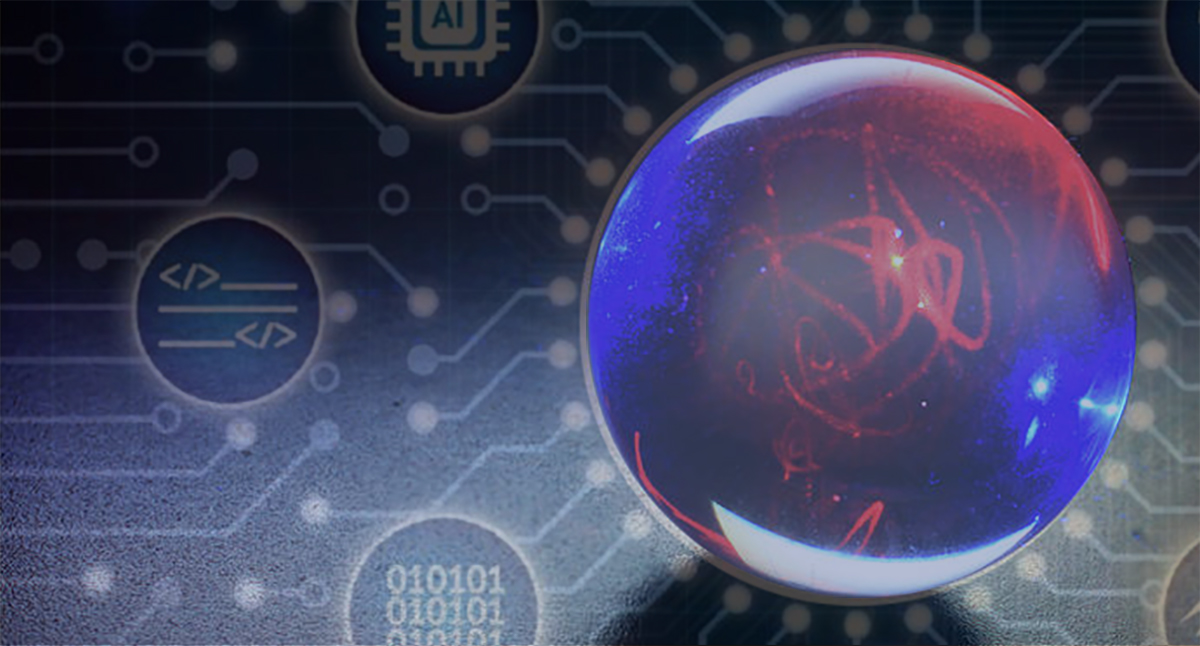In 2019, Paul DiPaola of U.S. Bank said, “the rate of change has never been faster, and it will never be this slow again.” 2020 certainly agreed and then decided to raise the stakes. We saw COVID lockdowns that forced both businesses and consumers to embrace digital as the primary channel for communication. Frictionless, secure, personal digital engagements went from a “nice to have” to “need to have” almost overnight.
As economies seesaw between re-opening and restrictions, consumers have come to rely on the convenience of digital customer engagements. As we look toward 2021, I sat down with the Glance leadership team to get their thoughts on the future of digital customer engagements.

What does the future hold for businesses and consumers in the “new normal”? While we may not have a crystal ball, here are some predictions of trends for 2021. Without further ado, here are the highlights:
Prediction #1: Enterprises will re-imagine the in-person to “in-digital-person”
In a recent report, Forrester predicted that, “Retailers and banks will create hybrid ‘store-contact center’ rep positions.” While we have seen this approach strategically planned out by some of our customers for a while, COVID certainly accelerated the execution phase. While we are not going back to the old way of doing business, what does this mean for enterprises?
Clyde: We are already seeing this hybrid experience combining digital engagement with human assistance with some of our customers—especially those in finance that have been really damaged by COVID. The whole experience of going into a branch or retail location to engage dropped off dramatically in 2020. If you can recreate that in-branch experience, through digital channels, that seems like a compelling and necessary move for the near term. In the long term, that can create all sorts of hybrid experiences and cross-functional opportunities.
Tom: Customer expectations have changed. For banking, I think we will see more of these hybrid-branches. The concept behind these hybrid branches are that banks will still have a physical presence. However, now you can walk in, and you will find a digital workstation that can perform an array of tasks. If you need human assistance, you will be able to set up an appointment with a knowledge expert who can help you in-person or virtually right then and there. The cost model is more efficient and allows for growth. If they can get digital right, they can grow and accelerate in ways not thought of two years ago.
Jeremy: Working from home has really blurred the lines, and that will continue to happen. What we’re seeing is retailers and banks tap into digital channels for providing expertise. For example, you see big mobile carriers who had to shut down their retail locations this year due to COVID and pivoted by offering human assistance in the digital shopping experience. As they start to move these in-person experiences online, we’ll start to see those retail employees more and more take part in the digital channels in their day-to-day responsibilities.
Rich: Retailers and banks have realized that people don’t want to have an in-person experience right now. That will be the case for a while. And what we are noticing is a change within their departments that provide advisory services, support, or sales. They are investing in ways to deliver that white glove experience without being in person. They know that you have a win-win situation whenever you can take friction and effort out of a customer experience.
Prediction #2: Customer Service will shift from cost centers to profit centers
As businesses and consumers moved to digital, the customer journey shifted as well. Customer support became the initial point of contact for customer engagement. Will this shift impact customer service interactions and business outcomes?
Clyde: Intuit is a good example of a company where you start to see customer service centers become profit centers. For example, you have a taxpayer stumped in the process of filing online. When they reach out to Intuit, it’s more than asking for help; the customer is asking for expertise. Agents, on the other side, can provide services for a fee. What customers are receiving is a white-glove experience. The consumer doesn’t feel like they are getting upcharge; they feel like they are getting value. Many businesses will look at that model and reflect on where they can find their own moments of opportunity embedded in an engagement.
Craig: This is critical for the hybrid bankers and tellers Tom had mentioned. It compliments a trend we see with our customers who are adding team members whose roles span both customer service and sales. They’re focused on revenue growth and the paths of enablement that will increase customer lifetime value.
Prediction #3: Contact center leaders will reorganize their firstline talent around centers of expertise
COVID-19 has also brought to light the complexity of support situations a customer service department regularly faces. Best-in-class support requires customer services leaders to take a more contextually driven approach to customer needs.
Jeremy: It’s a smart way to organize. Instead of having this system where you escalate from one level to the next, you have a team of cross-trained employees that have the tools and techniques to do more than their one function.
Tom: I see financial services as an industry that will embrace this trend. When you place employees in “pods” where they have a domain of expertise, you’ll start seeing these real personal conversations of high value. Having these pods that can connect knowledge workers with subject matter experts seems so logical because then you can have people who can speak inside their domains such as home loans or small business loans, that can give advice on best practices, and also expose the customer to other elements of the business. This type of focus can turn consumers into loyal customers.
Prediction #4: Enterprises will seek an in-app, in-domain branded experience for their customer collaboration
Whether it was personal or professional, web conferencing exploded this year. However, when it comes to brands, many of these web conferencing options provided friction in the customer journey and an out-of-brand experience. As enterprises strive to create a seamless experience, they will look towards providing an in-brand messaging experience.
Rich: Many companies see customer service at this moment as an expense center, and they see technologies like screen share, cobrowse, and video as commodities. But the innovators, the ones that care about their brand, and that care about the experience, will understand that the ability to create a branded experience — embedded in their domain, their website, their app — is priceless. You’ll start to see more businesses looking to create this branded in-app experience because they will be looking for a way to provide a secure and frictionless experience for their customers.
Jackie: If you think about a large financial services company or retailer, they’ve invested a lot in their brand. They’ve built secure websites and mobile apps, and spent time training their customers to go online to perform certain tasks. They want to expand the customer’s experience inside their trusted digital world. The last thing they want to do l is to say to a customer seeking help within their website is, “Hold on, wait a minute, I’m going to send you an invite via email to a video conference. We are going to click out of here, finish out the conversation in a video conference, and then you’ll come back into the website to finish out the transaction we were just talking about.” That doesn’t work because you are building friction for the customer, it’s time consuming, insecure, and the worst part is, you’re breaking this trusted, branded experience.
Ed: I would say it would be a positive trend for enterprises to embrace. Having a branded in-app experience helps create a seamless experience between physical locations and online interactions.
Prediction #5: The online customer journey will be a mix of human and bot
Tom: What you’ll see is a combination of technology complementing human contact. Low touch conversations such as password resets or order tracking will be automated, leaving room for employees to embrace the high touch moments.
Rich: A bot is a very useful tool for low touch issue resolution and for deflecting calls, but it’s not a brand builder. It’s not going to help you build loyalty. There is no trust or empathy with a bot. When you have multiple channels, you have the ability to build trust and loyalty. Video has become a diffuser tool for escalations. One of our clients noticed they could turn video on and turn the temperature down on support calls from very frustrated customers. This allowed them to then break out to a cobrowse session and provide exceptional service.
Jackie: Bots definitely have their place in low-value interactions. I don’t need to talk to a person to reset my password or pay my bill online. But if I’m trying to decide between a Roth IRA or a traditional IRA, I want to be escalated to a conversation right then and there. I don’t want to make an appointment for next Tuesday at 10 o’clock to hop on a video conference. I want to share my screen with a trusted advisor now, while I am ready to make the commitment. As bots get smarter, we will start to see these proactive moments, where they can detect and escalate the interaction to a subject matter expert before the customer gives up and looks to a competitor who will help them in the way they want to be helped.
Prediction #6: Video will rise in consumption
Forrester predicts that “Digital customer service interactions will increase by 40%.” What we also think will rise in 2021, is the adoption of video in customer service interactions.
Rich: The market has changed dramatically this year due to COVID. Video has become a common form of communication. You have children teaching their parents and their grandparents how to use it. It’s become understood that it’s part of human interaction. The familiarity that everyone has now with video, has opened up opportunities for brands, especially in the financial space, to offer these high-touch customer moments. Many enterprises have tasked themselves with finding out how to find these high-value touchpoints with their customers in 2021 and beyond.
Jackie: Customers are becoming so used to video, they are going to start expecting it in all their interactions with companies they are making purchases from. Video goes beyond face-to-face. Video has the ability to provide a shared experience, to see the same thing. That’s going to be the next logical step for a lot of industries. As consumers use video more and more, they’re going to find themselves wanting more than a face on the screen.. “I want to show you this. I want you to look at what I am seeing (on the screen or off screen) because it is so much easier than my trying to describe it to you..” This will result in higher sales, faster issue resolution and increased lifetime value of the customer.
Craig: Most of our customers have set up strategies to deflect calls from customers. We saw chat facilitate more self-service, low touch interactions. Where we saw in-person interactions reduce in 2020, video and voice became critical for high-touch moments with customers, and that’s a trend that won’t be going away. I think video will become more prevalent anywhere we see people looking to leverage trust. Companies that know that trust is critical will be the first to adopt video strategies.
Ed: Video combined with voice helps you de-escalate, because it allows your customer to see and hear your employees’ empathy. Video and voice are compelling for high-touch customer advisory moments, and that trend will continue to grow.
Tom: In the past, video was always an add-on. As we get into this world of guided collaboration, we will start to see a shift where video becomes the touchpoint that launches a cobrowse session. We are seeing technology allowing businesses to bring humans back into the equation of delivering great business outcomes.
Clyde: Video will really become pervasive and multi-partied going forward. In the past, we found that our customers weren’t using a lot of video because they were thinking about what it takes to utilize video as a communication channel. Now I think they are just past that, and they want video and want that type of engagement for those ad-hoc external relationships.
There will be a lot of chat, a lot of telephone calls, but to the extent of injecting human empathy, enterprises will want to add video to provide that full richness. Whether that video experience is in a meeting launch or in a layered experience, I think we will see that rise to the forefront.
When it comes to the future of relationships between businesses and consumers, the Glance leadership team has an optimistic outlook on 2021. Do you think 2021 will turn out the way we see it? Check back with us next December to see how we stack up!
If you’re looking to start this year off right, we recently released a whitepaper on how organizations can best prepare for digital transformation. Check it out to learn more about how today’s technologies can build trust and loyalty with your customers.



